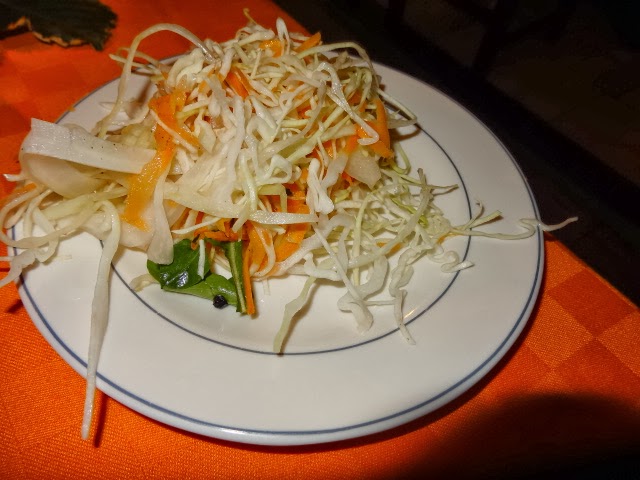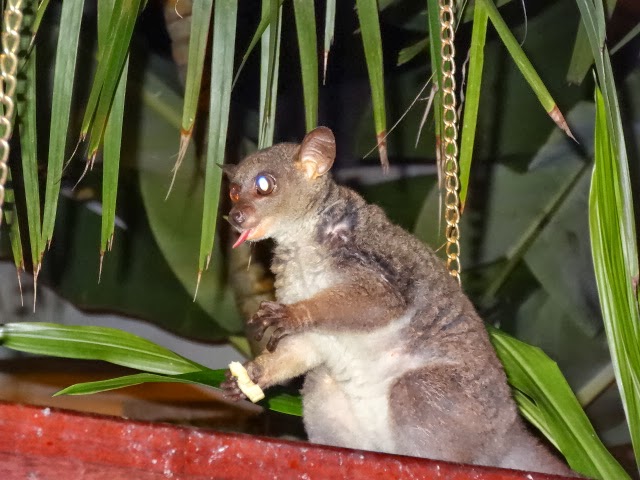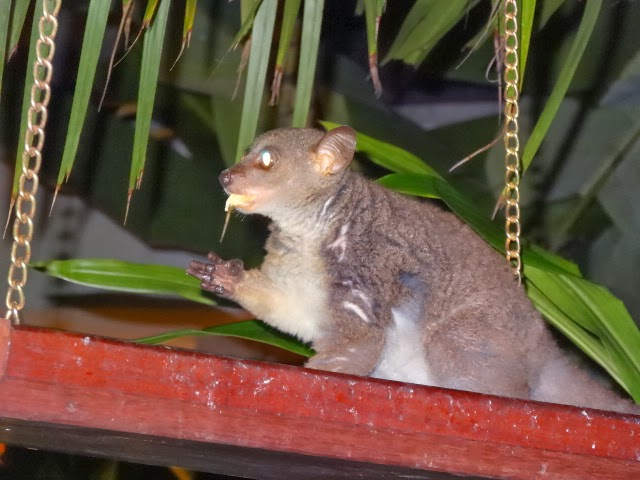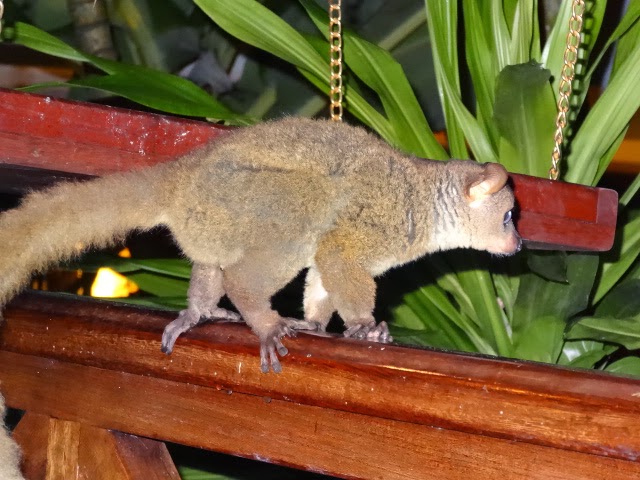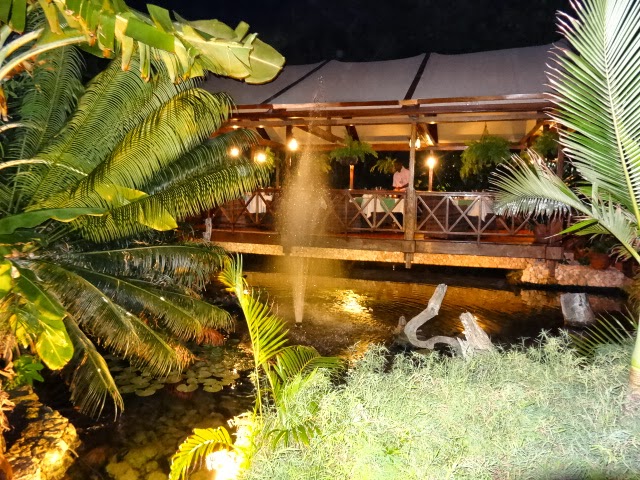 |
| We were mighty close to be able to get this giraffe headshot. Love it! |
Many of the sounds are similar minus the roosters crowing. The air is permeated with a vast array of bird songs we’ve never heard before. The steady hum of crickets and frogs quickly blend into our senses soon leaving us unaware of their constant chatter.
On occasion, the sounds halt momentarily when they sense a potential predator in the area. We hold our breath, waiting, hoping to see a “visitor.” So far, we’ve had only a few as shown in these photos. We have no doubt that others will follow.
 |
| It’s hard to believe that impalas roam among the houses here in Marloth Park. |
Our new driver, Okee Dokee (her nickname!), shared much information about the area during the hour and a half drive from the Mpumalanga Airport to the house. We stopped along the drive to buy a SIM card for my unlocked phone so we can make local calls as needed. One wouldn’t want to be in this area without a phone.
 |
| We didn’t need to see many wildebeest during the Great Migration. They are here in our neighborhood, hopefully making a personal visit soon. Love the baby! |
Also, we checked out the huge grocery store and for the first time in nine months, we saw a Kentucky Fried Chicken restaurant. The shopping area is a 25-minute drive from the house in the small town Komaatiport.
 |
||
This baby zebra was on the move checking us out, playfully leaping into the air!
|
In the future, Okee Dokee will be our driver for all trips. At some point, we may decide on a rental car. But, at the moment, we’re fine. Louise, the hostess to end all hostesses and property manager, asked me to make a grocery list for everything we’d need for the first week.
 |
| Dad kept a careful watch of the baby’s antics. |
I’ve never had anyone do all my grocery shopping. She did a fabulous job. Going through the cupboards, refrigerator and freezer felt like Christmas. Every item was beautifully arranged in the cupboard, things we love all of which were quality products.
 |
| Mom didn’t miss a moment of baby’s youthful shenanigans |
Louise spent a total of ZAR $2800, US $$274.43, leaving us with enough supplies, household products, and food to get through the week.We paid her back with the cash we’d collected from the ATM at the Johannesburg Airport.
 |
| Louise stocked the cupboard with nuts, seasoning, and other foodstuffs that we use. Gosh, I haven’t had use of a plastic container with a lid in almost a year. I’ll be spoiled! |
Marloth Park is a game reserve, sandwiched between Kruger National Park to the immediate north of us and Lionspruit, another game reserve. Although the Crocodile River acts as a barrier, it generally prevents the lions (although lions have been seen in Marloth Park on occasion) and elephants from visiting us.
 |
| At the house less than a half-hour, this warthog stopped by to welcome us to the neighborhood. He was our first official visitor. |
Without a doubt, other wildlife most will wander into this lush vegetation (its almost summer here) seeking food and out of curiosity. It will take time and patience while being camera ready at all times.
We’ve been warned, as we already knew, not to feed the animals, other than the approved nutritional pellets available at the feed store in huge bags. With summer fast approaching the bush has plenty of nourishment for the wildlife, whether they consume vegetation or hunt for their food.
Marloth Park was named after a German botanist, Rudolph Marloth. The Aloe (plant) Marlothi was named after him. There are aloe plants all over the yard and in the area. Over time, we’ll learn the various medicinal purposes of the Aloe plant and put some clippings to good use.
At the moment we are on the veranda watching and waiting for visitors. Currently, the temperature is 61F, 11C, with a cooling breeze. The biting flies, mosquitoes, and insects, although in abundance, are much less of an annoyance than they were in Kenya.
Last night, we slept under a lightweight down comforter covered in a fine cotton duvet with the air conditioning on, set at a low setting. It was wonderful, more appreciated than we’d have ever imagined. Ah, the simple things.
Louise had purchased a MiFi for the house for us which works fairly well with both of us online at the same time. But, Tom was unable to watch the Minnesota Vikings game, even if I was offline. Tomorrow, we’ll purchase SIM cards for our two MiFi’s to see if they will work better.
Most of South Africa’s citizens speak Afrikaans and English, although there is a total of 11 languages spoken. The locals seem to have a strong accent comparable to a combination of British, Dutch and Australian. We’re making every effort to learn a few words if we can get Swahili out of our brains, which is not spoken in South Africa.
 |
| Although exhausted and bleary-eyed, we didn’t want to miss a photo op. |
Are we comfortable? Yes. Do we like the house, the grounds, and the general area? Very much so.
Tomorrow, we’ll share photos of the interior of the house and soon, we’ll arrange our first safari in Kruger Park. But, for the moment, we’re content to continue to settle into our new environment as we tune our ears to the unbelievable sounds of the bush all around us.
Last night, we’d accidentally locked ourselves inside the house. All the doors and windows have steel accordion-type security gates to keep the animals out of the house. We’d closed up for the night but found we couldn’t open the doors after shutting them.
Sending Louise an email, within minutes she and her husband Danie warmly greeting us once again showing us how to unlock the security gates, a tricky process, although the gates appear to be fairly new.
Moments ago, an armed guard from the security company stopped by asking if our power was restored. Apparently, the power had been out for a few days last week as a result of a severe thunderstorm. Thank goodness it was restored prior to our arrival.
However, with the power out, the water system didn’t work. When we arrived, the water was a mere trickle. And, there was no hot water. By this morning, I was able to soak in a hot tub for the first time in a year. Of all the houses we’ve lived in these past 13 months, not one had a tub until now. In addition, there are two large tiled shower stalls.
The security guard warned us about keeping the house gates locked and not leaving any digital equipment unattended. In recent times, burglars had been visiting houses in the area, stealing laptops and cell phones. Without our own security guard on the property at all times as we had in Kenya, we’ll be especially careful.
Every location has its pluses and minuses. The hope is that we adapt to the minuses and revel in the pluses. It’s an ongoing process, undoubtedly filled with many surprises, of which living in Africa has in abundance.
















